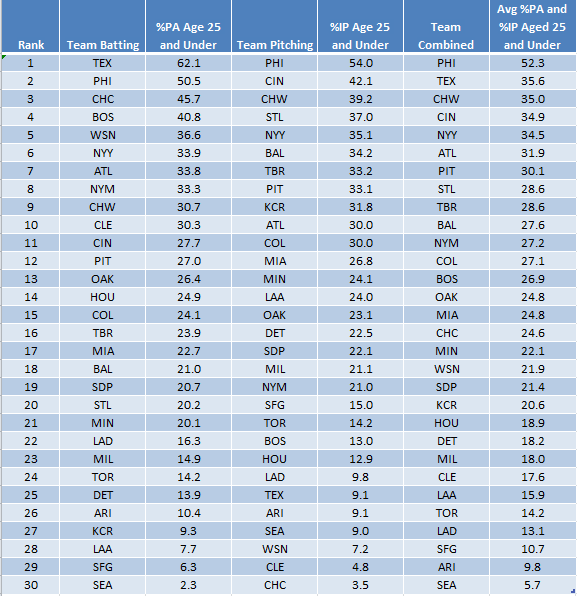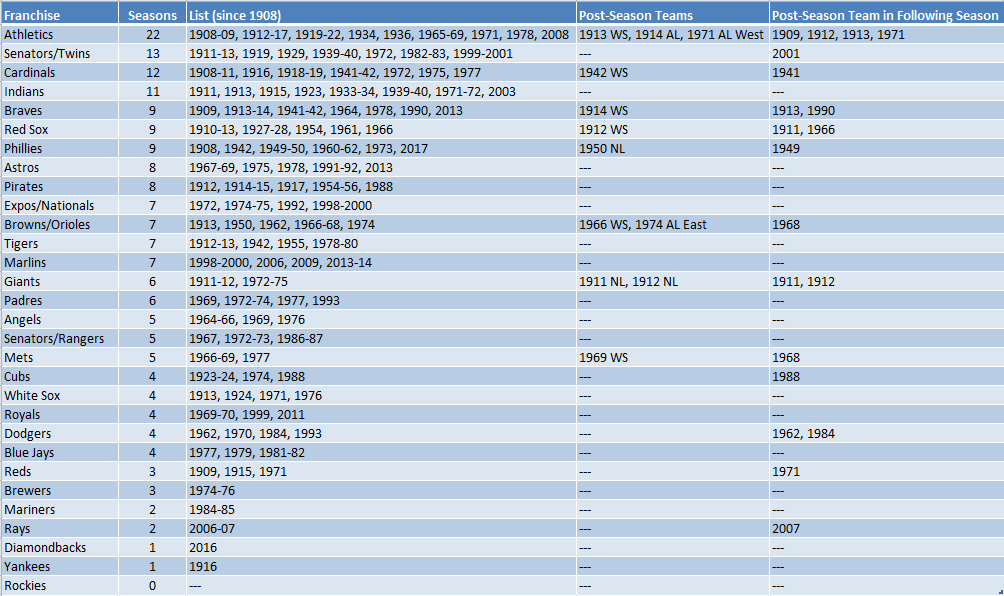The NL East has to be baseball’s surprise division this season, with the upstart Braves and Phillies so far besting the pre-season favorite Nationals, currently just a .500 team after running away with the division a year ago. For the Phillies, it’s their second straight year as a 40-40 club, a back-to-back they also accomplished in the 1949 and 1950 seasons, the latter a pennant-winning campaign. So, what’s a 40-40 team? If you guessed 40% of PA and 40% of IP given to players aged 25 and under, you nailed it. More after the jump.
Here are the numbers so far this year for each team. As is suggested by these numbers, 40-40 teams are fairly unusual, with only the Phillies making the grade this season, just as they were the only club to do so last year. That is consistent with the recent past that has seen more than one such team in only two seasons since 2001, in 2006 (two) and 2013 (three). If Philadelphia maintains its current pace and finishes the season as a 50-50 club, they would be just the second such team since 2001, following the 2006 Marlins.
As is suggested by these numbers, 40-40 teams are fairly unusual, with only the Phillies making the grade this season, just as they were the only club to do so last year. That is consistent with the recent past that has seen more than one such team in only two seasons since 2001, in 2006 (two) and 2013 (three). If Philadelphia maintains its current pace and finishes the season as a 50-50 club, they would be just the second such team since 2001, following the 2006 Marlins.
40-40 clubs haven’t always been so rare, as shown in the next chart. The spike in the 1900s and 1910s (it probably makes sense to combine those decades as the data only begin with the 1908 season) probably reflects scarcity of talent in the two seasons of the Federal League (although the FL itself had only one 40-40 club), pitchers tending to be younger under the cumulative effect of the heavy workloads of the time, and, possibly, the nature of the small ball offensive game tending to favor younger and faster players. The spikes in the 1960s and 1970s reflect some of the same factors, with talent scarcity in an expansion era, and another lower offensive environment favoring younger players and the speed game then in vogue.
The spike in the 1900s and 1910s (it probably makes sense to combine those decades as the data only begin with the 1908 season) probably reflects scarcity of talent in the two seasons of the Federal League (although the FL itself had only one 40-40 club), pitchers tending to be younger under the cumulative effect of the heavy workloads of the time, and, possibly, the nature of the small ball offensive game tending to favor younger and faster players. The spikes in the 1960s and 1970s reflect some of the same factors, with talent scarcity in an expansion era, and another lower offensive environment favoring younger players and the speed game then in vogue.
Were the Phillies to reach the post-season this year, they would be the first 40-40 team to do so since the 1970s. A 40-40 team may precede a period of success or may follow one as a team embarks on a rebuilding process (as the Phillies are doing now). Financial imperatives may also dictate a younger roster, examples of which are indicated in the table below. The A’s and, in the current era, the Marlins, are the prime examples of financially-driven 40-40 clubs. Included among the A’s 22 40-40 seasons are a run of ten such clubs (including two pennant winners) in 11 years (1912-22), and a 5-year run (1965-69) and another season in 1971, the last the first of 5 straight post-season appearances. At the other extreme is baseball’s most successful franchise, with the Yankees having had but one such season and that more than a century ago (the current Yankees, like last year having 25-and-under batters and pitchers both above the 30% mark, are the youngest since 1970).
The A’s and, in the current era, the Marlins, are the prime examples of financially-driven 40-40 clubs. Included among the A’s 22 40-40 seasons are a run of ten such clubs (including two pennant winners) in 11 years (1912-22), and a 5-year run (1965-69) and another season in 1971, the last the first of 5 straight post-season appearances. At the other extreme is baseball’s most successful franchise, with the Yankees having had but one such season and that more than a century ago (the current Yankees, like last year having 25-and-under batters and pitchers both above the 30% mark, are the youngest since 1970).
The best and worst 40-40 teams are both from the dead-ball era, with the 1912 Red Sox boasting a .691 W-L% while the 1916 A’s recorded only a .235 mark (36-117), the lowest of any team since 1901. Plotting season by W-L% yields this picture. While 40-40 teams that post winning records are definitely the exception rather than the rule, the recent incidence of very bad 40-40 teams (shaded area) does seem to have diminished over the past 35 years or so.
While 40-40 teams that post winning records are definitely the exception rather than the rule, the recent incidence of very bad 40-40 teams (shaded area) does seem to have diminished over the past 35 years or so.
Thanks as always goes to baseball-reference.com for making available the data used to prepare this analysis.

